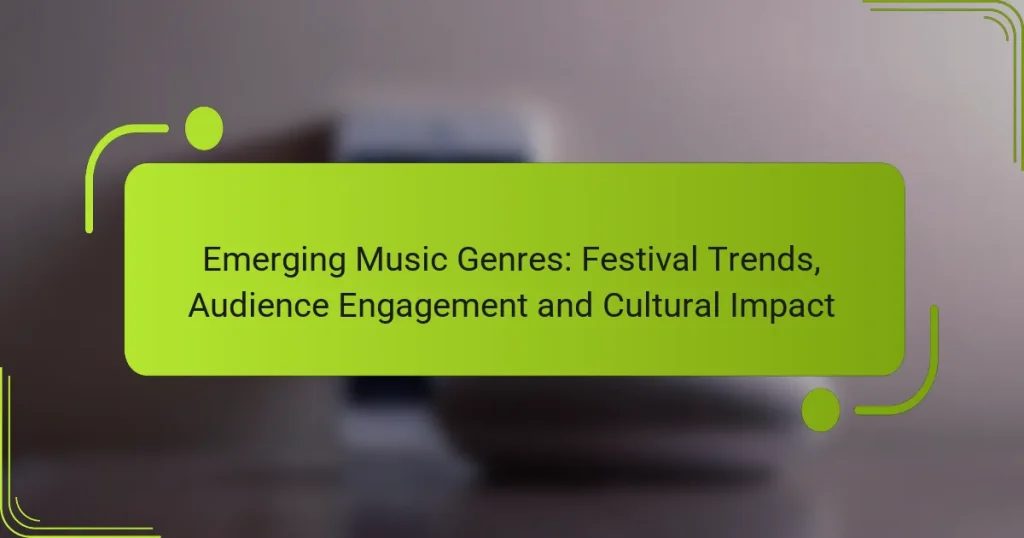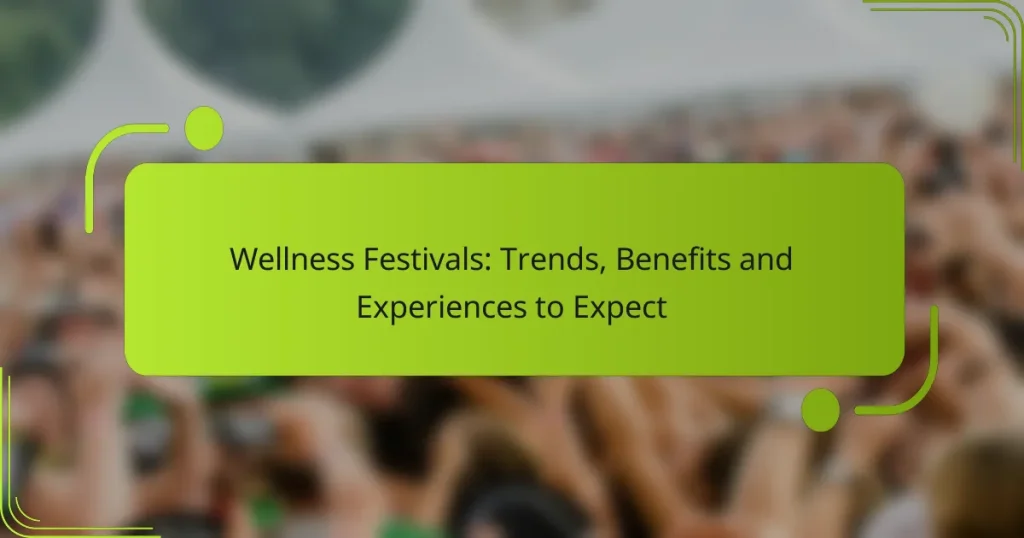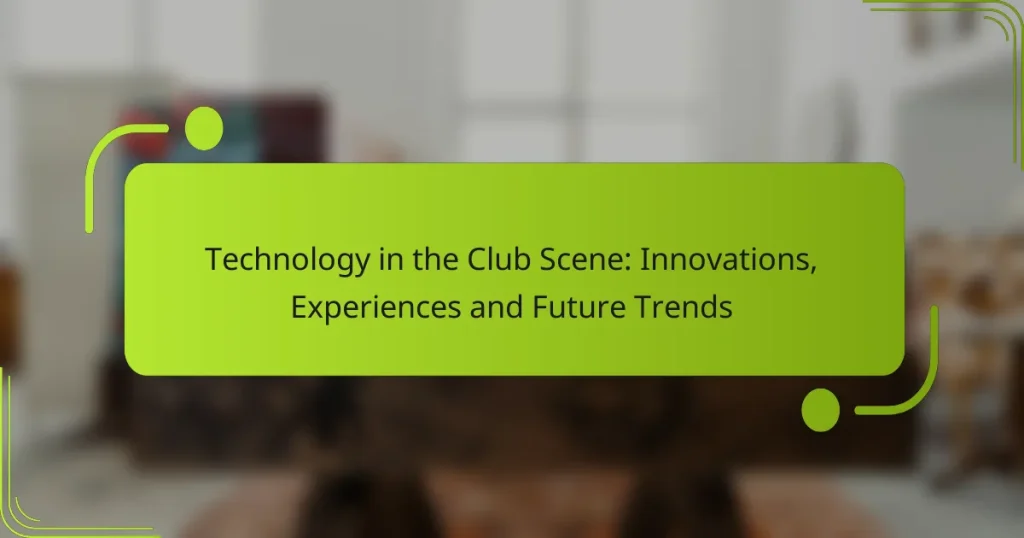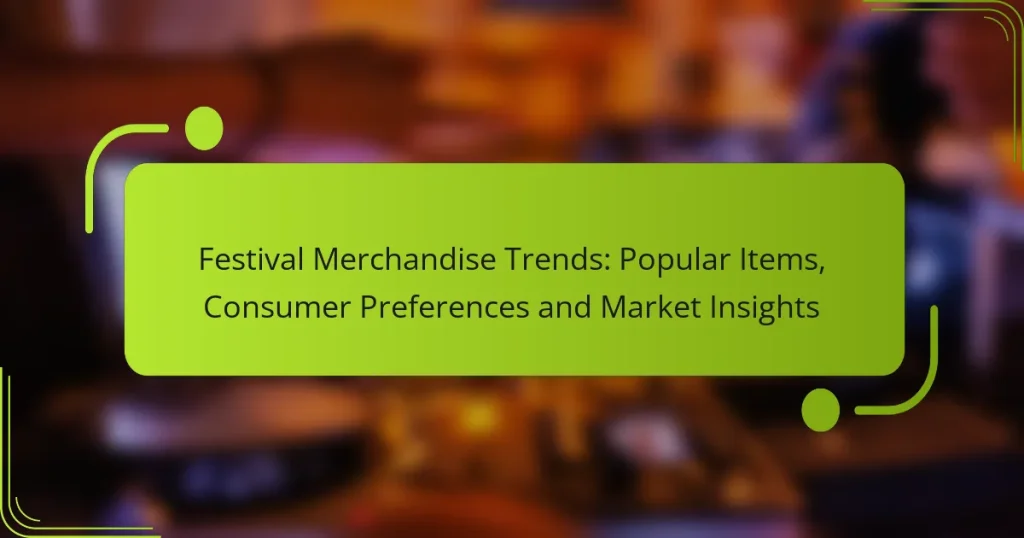The landscape of festivals and clubs is evolving, with emerging trends emphasizing inclusivity, sustainability, and advanced technology. As event organizers adapt to these changes, they are focusing on hybrid formats and eco-friendly practices that enhance attendee engagement and broaden their reach. This transformation is driven by the demand for unique experiences and the power of social connections in shaping memorable events.
Wellness Festivals: Trends, Benefits and Experiences to Expect
Technology in the Club Scene: Innovations, Experiences and Future Trends
Sustainability in Music Festivals: Practices, Innovations and Future Directions
Social Justice Movements: Festival Lineups, Representation and Audience Response
Themed Festivals: Popularity, Unique Experiences and Cultural Significance
Festival Merchandise Trends: Popular Items, Consumer Preferences and Market Insights
What are the emerging trends in festivals and clubs?
Emerging trends in festivals and clubs reflect a shift towards more inclusive, sustainable, and technologically advanced experiences. These trends are reshaping how attendees engage with events, focusing on hybrid formats, eco-friendly practices, and niche music genres.
Hybrid events combining virtual and in-person experiences
Hybrid events blend virtual and in-person elements, allowing broader participation and engagement. Attendees can choose to join physically or online, catering to diverse preferences and circumstances.
For example, festivals may offer live-streamed performances alongside on-site activities, enabling remote viewers to interact through chat or social media. This approach can increase ticket sales and expand audience reach significantly.
Focus on sustainability and eco-friendly practices
Many festivals and clubs are prioritizing sustainability by implementing eco-friendly practices. This includes reducing waste, using renewable energy sources, and promoting recycling initiatives.
Event organizers can adopt strategies like digital ticketing to minimize paper use and encourage attendees to use public transport or carpooling. Such practices not only appeal to environmentally conscious consumers but can also reduce operational costs.
Integration of technology for enhanced experiences
Technology plays a crucial role in enhancing festival and club experiences through innovations like augmented reality (AR) and mobile apps. These tools can provide interactive maps, real-time updates, and personalized schedules for attendees.
For instance, using AR, attendees can access exclusive content or interactive features at specific locations within the venue. This tech integration can lead to higher engagement and satisfaction levels among participants.
Rise of niche music genres and themed festivals
There is a growing trend towards niche music genres and themed festivals that cater to specific audiences. This allows organizers to create unique experiences that resonate deeply with particular communities.
Examples include festivals dedicated to electronic dance music, indie rock, or cultural themes, attracting dedicated fans and fostering a sense of belonging. Such focused events often lead to stronger brand loyalty and community building within the music scene.
How are festivals adapting to digital transformation?
Festivals are increasingly embracing digital transformation to enhance attendee experiences and broaden their reach. This adaptation includes leveraging technology to create virtual experiences, engage audiences, and streamline operations.
Utilization of live streaming platforms like Twitch
Live streaming platforms such as Twitch are becoming essential for festivals aiming to reach a global audience. By broadcasting performances and events online, festivals can attract viewers who may not be able to attend in person, thus expanding their audience base significantly.
Festivals can also engage with viewers through real-time chats and interactive features, enhancing the overall experience. This approach not only increases ticket sales but also opens up sponsorship opportunities from brands looking to connect with a wider demographic.
Incorporation of mobile apps for attendee engagement
Mobile apps are vital tools for improving attendee engagement at festivals. These apps can provide essential information such as schedules, maps, and artist lineups, ensuring that attendees have a seamless experience.
Additionally, features like push notifications and social media integration allow festivals to communicate directly with attendees, promoting real-time updates and special offers. To maximize effectiveness, festivals should prioritize user-friendly design and ensure that the app is available on both iOS and Android platforms.
What are the key factors driving festival attendance?
Key factors driving festival attendance include the appeal of unique experiences, effective marketing strategies, and the influence of social connections. Festivals that leverage these elements tend to attract larger crowds and create memorable events.
Influence of social media marketing
Social media marketing plays a crucial role in boosting festival attendance by creating buzz and engaging potential attendees. Platforms like Instagram and TikTok allow festivals to showcase highlights, share behind-the-scenes content, and connect with audiences in real-time.
Effective campaigns often include user-generated content, where attendees share their experiences, further amplifying reach. Festivals that actively engage with their audience online can see attendance increases of 20-30% compared to those with minimal social media presence.
Collaborations with popular artists and influencers
Collaborating with well-known artists and influencers can significantly enhance a festival’s appeal and draw larger crowds. When a popular artist is involved, their fanbase is likely to attend, increasing ticket sales and overall visibility.
Influencer partnerships can also help festivals reach niche markets. For example, a festival that features a popular electronic music DJ and partners with lifestyle influencers can attract both music fans and those interested in lifestyle content, broadening its audience base.
What are the challenges faced by festival organizers?
Festival organizers encounter various challenges, including managing health and safety regulations and addressing environmental concerns. These issues require careful planning and compliance to ensure a successful event.
Managing health and safety regulations
Health and safety regulations are critical for festival organizers to protect attendees and staff. Compliance involves understanding local laws, such as crowd control measures, emergency response protocols, and food safety standards.
Organizers should conduct thorough risk assessments to identify potential hazards and implement appropriate measures. This may include hiring medical personnel, setting up first aid stations, and ensuring proper sanitation facilities are available.
Addressing environmental concerns
Environmental concerns are increasingly important for festival organizers, as public awareness of sustainability grows. Organizers must consider waste management, energy consumption, and the ecological impact of their events.
Implementing practices such as recycling programs, using renewable energy sources, and minimizing single-use plastics can significantly reduce a festival’s environmental footprint. Additionally, collaborating with local environmental organizations can enhance sustainability efforts and community relations.
How do festivals enhance attendee experience?
Festivals enhance attendee experience by creating engaging environments that foster connection and enjoyment. Through unique activities, diverse offerings, and interactive elements, festivals provide memorable moments that resonate with participants long after the event.
Interactive installations and immersive art
Interactive installations and immersive art are key features at many festivals, allowing attendees to engage with their surroundings in meaningful ways. These installations often encourage participation, transforming passive observers into active participants, which can significantly enhance the overall experience.
For example, festivals may include large-scale art pieces that respond to audience movement or sound, creating a dynamic atmosphere. Attendees can explore these installations, often leading to social interactions and shared experiences that deepen their connection to the event.
Curated food and beverage offerings
Curated food and beverage offerings play a crucial role in enhancing the festival experience by providing attendees with high-quality, diverse options. Rather than standard fare, festivals often feature local vendors and unique culinary creations that reflect the culture and theme of the event.
For instance, a music festival might showcase food trucks serving gourmet street food or craft beverages from local breweries. This not only supports local businesses but also allows attendees to explore new flavors, making their festival experience richer and more enjoyable.
What are the future predictions for festivals and clubs?
The future of festivals and clubs is expected to focus on enhanced experiences through technology, sustainability, and community engagement. As consumer preferences evolve, organizers will increasingly leverage data analytics and global networks to tailor events that resonate with diverse audiences.
Increased personalization through data analytics
Data analytics will play a crucial role in personalizing festival and club experiences. By analyzing attendee preferences and behaviors, organizers can create targeted marketing campaigns and customized event offerings. For instance, using data to recommend specific artists or activities based on past attendance can significantly enhance engagement.
Event planners should consider implementing tools that track attendee interactions, such as mobile apps or ticketing systems that gather feedback. This information can help refine future events, ensuring they align with audience expectations and preferences.
Expansion of global festival networks
The expansion of global festival networks is set to create more opportunities for collaboration and cultural exchange. Festivals are increasingly partnering across borders, allowing for a diverse lineup of artists and experiences that appeal to a wider audience. This trend not only enriches the festival experience but also fosters a sense of community among attendees from different backgrounds.
Organizers should explore partnerships with international festivals to share resources, talent, and marketing strategies. This can lead to innovative programming and attract attendees who are eager to experience a blend of global cultures. However, it is essential to maintain the unique identity of each event to ensure authenticity and local relevance.






